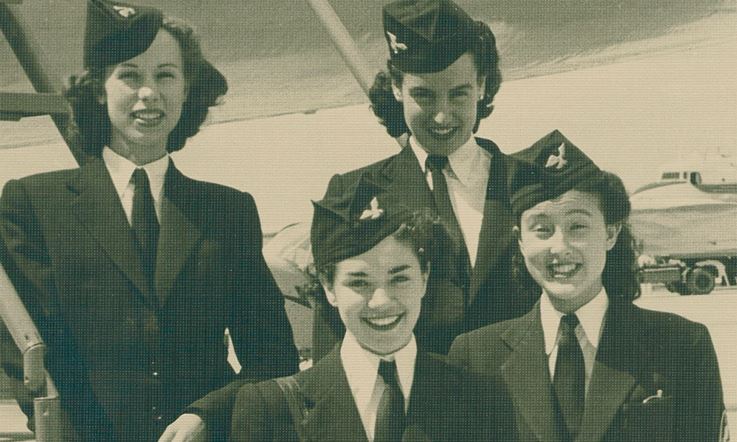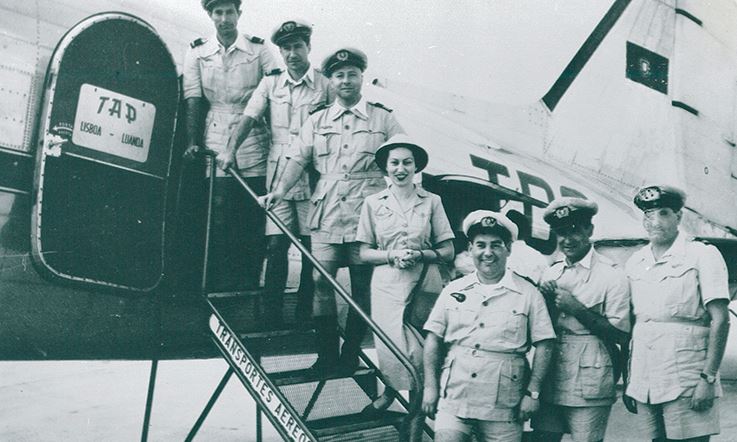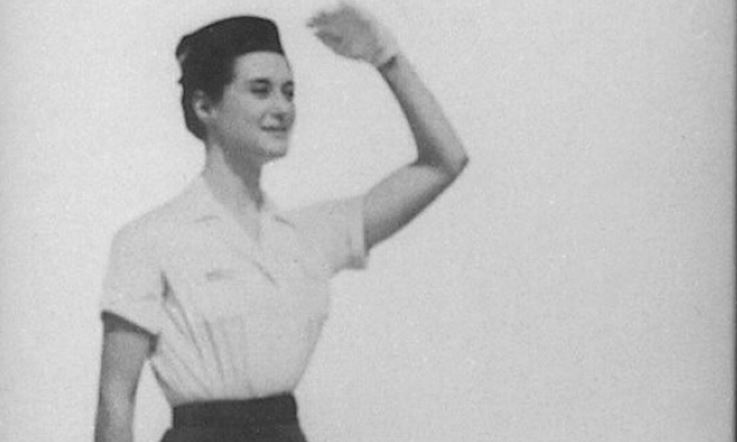Il trasporto dei bagagli da stiva è gratuito su tutti i voli, eccetto per chi viaggia con tariffa tap|discount. Se facesse al caso suo, la informiamo che può acquistare questo servizio nella prossima fase.
Se viaggia col bagaglio da stiva e ha un volo che fa scalo in Brasile, negli Stati Uniti o in Canada, tenga presente che è obbligatorio ritirare il suo bagaglio in questi paesi per il controllo doganale. Segua poi le indicazioni e si diriga verso il ritiro bagagli.
A journey through the history of TAP uniforms
The history of aviation is written in many ways. In many languages and many places, it is written in the engineering that conceived the “flying machines” that are airplanes, it is written in the places that we can reach today in just a few hours, it is written in the memories of the passengers of all times, it is written in the airbridges, in moments of happiness or nostalgia, in departures, arrivals and on board.
It is also written in design and fashion. Corporate logos, marketing, and advertising materials, in-flight tableware, or special aircraft paintings are some examples that mark moments in the history of an airline. Another example – and perhaps one of the most iconic – is the one of the cabin crew uniforms.
One of the possible perspectives on the History of TAP Air Portugal is this: what have flight attendants worn in over almost eight decades?

Comprising a dark blue blazer and dark blue skirt, a beige collared blouse, a black tie, a military-inspired bivouac, and black shoes with thick high heels and laces, TAP's first female uniform was designed by British Lucienne Marie Summers, who would go down in TAP's history as Miss Summers, coming from the British Overseas Airways Corporation (BOAC) and instructor of the first flight attendant’s class of the newly created Portuguese airline. Worn by TAP’s cabin crew for the first three years of the company's life, this first uniform also wore its second logo, changed in 1947.

The so-called “tropical uniform” is one of the most iconic in TAP's history. Comprising a short-sleeved blouse, twill skirt and khaki panama hat, thick high-heeled shoes, and a honey-colored leather bag, its authorship is unknown, but attributable to crew members. Used only on the Africa Line, a kind of “summer uniform” to be used in tropical climates, it coincided in time with the company's first two uniforms.

As of 1948, the flight attendants’ uniform was updated, losing its military-inspired elements, such as the bivouac and the tie, and gaining in elegance and femininity. Authored by the crew members themselves, the dark blue blazer and skirt with side pleats, and the new white blouse were now accompanied by a felt hat, with a rounded shape and a small brim, and by thin high-heeled shoes and a black suitcase. In the six years that it could be seen on board, this uniform also carried two TAP logos.

The arrival of the Super Constellation aircraft was also an occasion to change the crew's uniforms again. TAP's third uniform thus marked the return to a more militaristic model. The color changed from dark blue to gray and the tie and bivouac were back. A tight-fitting skirt, halfway up the leg and with two pleats at the front and a belted jacket, gave the uniform a very feminine style. Designed by Captain Silva Soares, who was also the airline’s chief pilot, this also became the only uniform in use.

A year later, dark blue is once again the dominant color of the flight attendants' uniforms, and this was the main alteration made to the new version. Still keeping some of its militaristic cut, the switch to blue and the loss of the tie gave a renewed appearance to the crew members who, for the onboard service, also gained the alternative of flat shoes, more functional, showing greater attention to comfort and to the safety of workers.

Although the authorship of this new uniform is not confirmed, it is almost certain that it was created by Ana Maravilhas, whose haute couture productions were in high demand at the time and who even created several stage dresses for Amália Rodrigues. The new uniform of TAP’s flight attendants broke with the military line followed since the company's founding, eliminating the bivouac and adding a white silk scarf, which could be worn over the hat, “à algarvia" (in the Algarve style), at the same time a national and regional note and wind protection.

The second half of the 60s brought a new color to TAP's planes, with a markedly more modern and less formal identity. The stylist Sérgio Sampaio introduced significant changes to the crew's uniform, starting with the color right away, which became teal. The military-style bivouac gave way to a felt hat decorated with two pom-poms, inspired by the regional costume of the women of Nazaré, combining modernity and tradition. This model also consisted of a blazer and skirt, which uncovered the knees, and a yellow collared blouse. White mousse gloves completed the ensemble.

With Frenchman Louis Féraud's signature, the uniform that is still considered one of the most iconic in TAP's history, brought a revolution in color and fashion to the national airline. The suits were replaced by over-the-knee dresses, with three dominant color choices – yellow, red, and blue. The hat had a small brim and a Nazarene pompom (adapting this point of the precursor stylist) and the shoes had medium and thick heels, with a metallic application. The white silk scarves complemented the uniforms worn by TAP crew members throughout the decade.

In 1980, Féraud once again won the competition launched by TAP to create new crew uniforms. In line with the new TAP Air Portugal image and logo, the couturier signed the return of dark blue to the uniforms, with red and green accents. The uniform consisted of a short blazer and a dark blue pleated skirt. The blouses could be red, with stripes or white with bright colors, with short or long sleeves. The hat was made of felt with a wide brim in dark blue, high shoes or boots, and a suitcase made of dark blue and red calf.

Louis Féraud once again signs the changes made to the uniforms of TAP's crew members, which were in force until 2007, thus marking the French creator's dominance in the image that TAP carried around the world for decades. Continuing in the line of the previous uniform, this new version introduced a profusion of accessories in assorted colors and golden tones, the gold buttons with the 4th airline logo, the dark blue cardigan with detachable collars, and the raincoat.

The last competition for the renewal of uniforms was aimed at Portuguese creators. The duo Manuel Alves and José Manuel Gonçalves signed the new image of the crew, which is still in force today. Green and red are the dominant colors the flight attendants can choose from, combined with dark blue. Dynamic and versatile, this uniform allows crew members to choose between several pieces, which include pants, dresses, overcoats, blazers, coats, and knitted sweaters, among other elements. In 2019, flight attendants also started to wear insignia – in this case, golden stars – that identify the roles of flight attendant, purser, or cabin supervisor.

Over the nearly 80 years of TAP's history, changes in the uniforms of female cabin crew members have been more significant. The men's uniforms, although they have also undergone changes over the years, have always maintained a more militaristic line. Of note are the men's version of the tropical uniform and the burgundy service jacket that Louis Féraud introduced in 1970.

